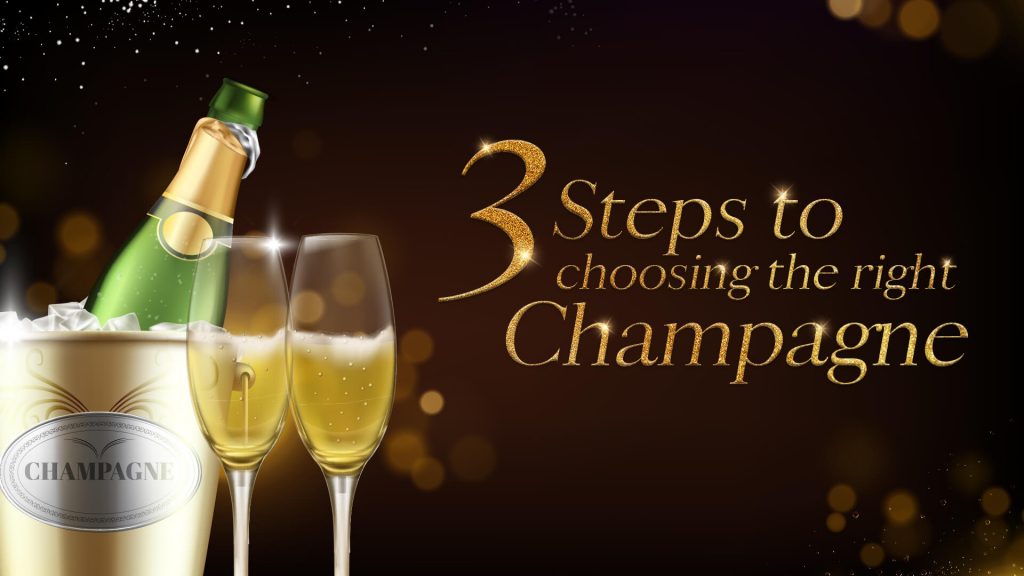Blog
3 Steps To Choosing The Right Champagne
Opening a bottle of champagne is a joyous experience, as are the enticing bubbles and the big smiles on everyone’s face. Every sip of this fizzy beverage brings with it an exhilarating sense of happiness and celebration.
RELATED: Choose The Right Wine For Your Wedding
Finding the best one, however, might be a difficult process. Check out our tips and useful terms below to help us navigate the ever-growing selection of fizzy beverages on the market today.
1. Know the difference between Champagne and other Sparkling Wines
All Champagnes are sparkling wine, but not all sparkling wines are Champagne.
Champagne
Champagne is unique because it must be made in the Champagne region of France. This represents the northernmost point at which vines can be grown. There are only three approved grape varieties, Chardonnay, Pinot Noir, and Pinot Meunier, and it is definitely challenging to cultivate them. Furthermore, only the ‘Traditional Method’ of champagne making – the Méthode Champenoise – is allowed. This is the most expensive and labor-intensive method, hence the reason that champagne usually comes with a higher price tag. A good bottle of Champagne can start from SGD$70-85 onwards.
Franciacorta
Franciacorta is a sparkling wine made in Northwest Italy. Other than Champagne, there are several high-quality sparkling wines that also use the traditional method and Franciacorta is one of them. As a result of being closer to the Mediterranean and having a warmer climate, the grapes are a lot riper than those in Champagne. Hence, most Franciacorta producers would add much less sugar to the final wine and allow the fruitiness to shine through. Usually a good bottle of Franciacorta costs around SGD$60-75
Prosecco
Prosecco is produced in northeast Italy using the Tank Method. This means that the wine gains bubbles in a big tank before being transferred into the bottle. Hence the mouth texture of Prosecco is usually not as fine as Champagne. Good for value Proseccos can range from SGD$25-35.
Sparkling wine
Sparkling wines obtain their fizz through a variety of methods, including the classic approach and even the Coca-Cola carbonation technique. After all, a wine that isn’t made in Champagne can only emulate Champagne; but can never be the real thing.
2. Find your sweet spot
At the end of the production process, Champagne is given a final dosage of sugar, and the sweetness of the Champagne is therefore determined by the amount of sugar it contains. Champagne labels will usually display the sweetness level, as stated below, from dry to sweet.
Brut and Extra Brut
These are the most popular styles nowadays, because they are highly versatile. Thanks to their ‘lively’ acidity, they can be paired with a wide variety of dishes. In the event that you want to serve finger food, or nibbles like salad and chips, a bottle of dry Champagne is the best option.
Demi-sec, Sec and Extra Sec
Now we are on the sweeter side of the spectrum, but not yet as sweet as dessert wines. There are some people who don’t want their champagnes to be too acidic, and this champagne may be just right for you! It’s also worth noting that they go nicely with spicy Asian cuisine.
Doux
This decadently delicious design is ideal for a sweet treat. On its own, it’s delicious, but it’s even better combined with crème brulee.
3. Choose a Style
Additional labeling terms can be seen on the label. It is possible to use these as a guide to determine the champagne’s style.
Non-Vintage (NV)
This is the most common style, and each Champagne house will have their ‘signature’ taste. To preserve a consistent house style, winemakers will blend the recent vintage wine with the reserve wine. The minimum aging requirement is 15 months.
Vintage Champagne
Vintage Champagnes are only made in great years, and the grapes used must be from that year’s vintage. The idea is to showcase the Champagne house’s style as well as the distinctive characteristics of that growing season. The minimum aging requirement is 3 years.
Reserve
For more sophisticated outcomes, the wine will be matured for an extended period of time.
Prestige Cuvee
It is used for a producer’s best wines, whether vintage or non-vintage.
RELATED: A Simple Guide To Building Your Palate For Wine
Most Champagne houses have developed their own signature style, and you may find yourself returning to your preferred style again and again. Our tip is to not be afraid to splurge on exceptional occasions. You may find that paying a little extra is worth a lot more. You might also find that in the long run a bit extra might earn you a lot more value.



